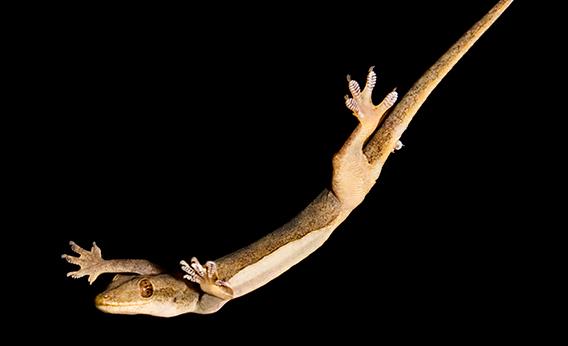
How the University of California Harnesses Nature’s Super Powers
From gecko-inspired climbing gear to robotic vehicles that can sprint over sand, University of California researchers are looking to the natural world for breakthrough ideas that can turn ordinary people into super humans.

The University of California is known for scientific breakthroughs that change the way we live. Many of their designs are inspired by the awesome abilities that naturally occur in the animal kingdom.
Comic book superheroes like Spider-Man, Batman and the Wasp boast powers that mimic nature. Spider-Man spins super-strong webs and crawls walls, Batman uses sonar lenses to locate foes in the dark and the Wasp can bring down her enemies with a single sting.
Now, University of California researchers are replicating the amazing adaptations of fish, lizards and insects and using them for human advantage.
You might think twice about poking a toe in the Amazon River, but there’s one hefty fish that has no need to fear its predators. The Brazilian arapaima has evolved an impenetrable layer of armored scales that protect it from the piranha’s bite.
When UC San Diego researchers took a closer look at this remarkable fish, they saw potential for an entirely new kind of military grade body armor.
Professor Marc Meyers of UC San Diego’s Jacobs School of Engineering leads the team that, inspired by arapaima, is developing a class of high-tech ceramic materials that are hard, light and flexible.
“I was fishing for arapaima and realized that they live in lakes infested with piranha,” said Meyers.
Meyers began to wonder about the properties of this special fish. As he reviewed the existing literature, he was surprised to discover that no one had studied the arapaima’s resistance to the piranha’s deadly bite.
“The arapaima has unique armor. It has a surface layer that is highly mineralized and therefore hard. This rides on a foundation made of collagen organized in cross-plied layers. Thus, the scales are both hard and flexible.”
Soon, the arapaima’s superpower will be more widely applied – as Meyer’s new, flexible ceramics make possible a range of products, from bullet-proof body armor to puncture-resistant packaging.
And that's just one example of bio-inspiration in action.
Lizard Power
University of California researchers have also produced a dry adhesive that enables climbers to cling to sheer surfaces — just like your friendly neighborhood Spider-Man. No radioactive arachnids were required in the manufacture of this incredible material, just your average gravity-defying gecko.
UC Berkeley Professor Robert Full leads the lab that developed the adhesive. He demonstrated the climbing capabilities of gecko-inspired materials in a TED talk, sharing footage of climbers scaling vertical glass surfaces with special, dry adhesive pads.
The material works just like the gecko’s feet, which are covered with thousands of microscopic hairs known as “setae.” The hairs bond with the surface at a molecular level.
"This work is driven by curiosity,” said Full, “We look at the gecko, and think, ‘How is the gecko able to run along that wall?’ ”
That curiosity has produced some astounding technological breakthroughs.
Wheels and sand don’t mix well. But geckos, with their shimmying movements and widely splayed feet, can sprint across the dunes. By mapping how geckos run on sand, Full's research has helped engineers develop prototype vehicles that traverse desert landscapes faster and more effectively.
Geckos are also inspiring new ways of thinking about stability: their tails allow them to right themselves mid-air when they fall.
“Unlike cats, who rotate their bodies when falling, the gecko is one of the few to use its tail to do this,” Full said.
Full's research into how the gecko uses its tail opens up the very real possibility of robotic vehicles capable of climbing walls — just like the Batmobile.
Full imagines a future in which vehicles can glide and robots have stabilizing tails.
"It’s an example of how basic research leads to unexpected applications,” Full said. “Engineering can be inspired by biology and its principles. Integrating that with the best human engineering can ultimately make something that’s better than nature.”
Amazing Spider Strength
In at least one case, UC research is muddying the water where comics end and science begins.
Spider-Man fans know that Peter Parker’s powers came from the bite of a radioactive spider.
But it was Parker's scientific know-how that helped him create Spidey's webbing. The secret formula was so strong that he could swing from skyscraper to rooftop on long strands of the stuff. It could be fashioned into armor, used to tie up villains or made into a sticky trap.
In an amazing case of science imitating art, similar applications are emerging from the lab of UC Riverside professor Cheryl Hayashi.
Her research into the properties of spider silk promises a range of uses, from surgical thread to toughened fabrics.
“Spider silk can be used in applications that would benefit from lightweight, strong, tough materials,” Hayashi said. “Studies have shown that silks have great promise for incorporation into a variety of technologies, including medical devices, high-value textiles, and electronics.”
The diversity of applications for spider-silk-inspired products is wide because there are so many different strains in nature.
“Most spiders spin more than one type of silk, with each type specialized for a particular task,” Hayashi said. “For example, the frame of an orb web is made from a very strong type of silk while the capture spiral is made from a super stretchy type of silk. Some of the properties of spider silks are truly surprising—dragline silk can conduct heat as well as any metal!”
Researchers have one obstacle to overcome – the large scale production of spider-silk inspired materials.
“Major advances have been made by researchers around the world to efficiently produce synthetic spider silk,” Hayashi said, “Currently, I have to turn down requests from inventors that want pounds of silk to try out their exciting ideas.”